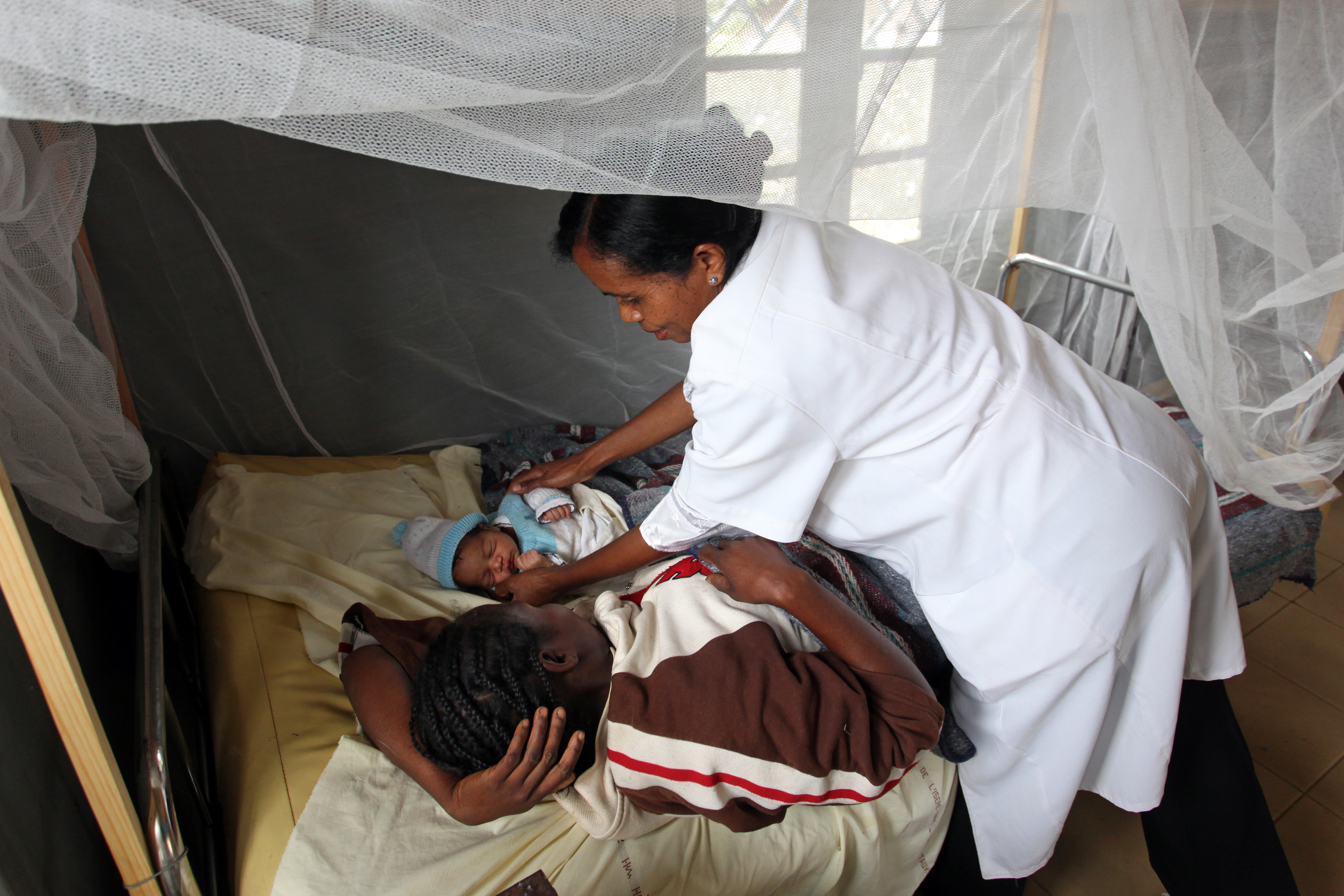June 2, 2016

© The Global Fund/Georges Merillon
This photograph captured a precious, joyful moment between a mother, Solange, and her 1-day-old baby, Jessy. Solange gave birth to Jessy in her regional health center, which also treats diseases like tuberculosis and malaria. In the maternity ward, thanks to health system strengthening efforts that connect vertical health programs, Solange and Jessy were able to stay under an insecticide-treated net (ITN) to protect themselves from mosquitos carrying malaria-causing parasites.
This is an incredibly important, Global Fund-supported intervention that has great implications for both maternal and newborn health. Welcoming a new life into the world shouldn’t spell disaster for women and their families. Yet, as of 2015, there were still 216 maternal deaths for every 100,000 live births. What’s striking is that 75 percent of maternal deaths are preventable. Malaria infection, among other complications during pregnancy and childbirth, is preventable. In addition, preventive treatment for malaria can have a variety of positive effects on health, such as avoiding anemia during pregnancy. Other interventions, such as the ITN that protected Solange and Jessy, can help prevent malaria infection both during pregnancy and after the baby is born.
At the recent Women Deliver conference in Copenhagen, Koki Agarwal, Director of Jhpiego’s Maternal and Child Survival Program, discussed the challenges regarding malaria in pregnancy. In her remarks, Agarwal highlighted that ITNs are the only preventive strategy in the first trimester of pregnancy. Afterward, intermittent preventive treatment in pregnancy (IPTp) is both successful and cost effective; it’s only 12 cents per dose.
But the need is great and the stakes are high: malaria infections during pregnancy cause 10,000 maternal deaths each year.
Pregnant women and their babies are also vulnerable to diseases such as tuberculosis (TB). According to the TB Alliance, 6-15 percent of all maternal deaths are caused by TB. In addition, a baby is at six times the risk of dying just before or after birth when the mother has TB. Integrating TB preventive care and screening services into antenatal care visits is crucial for the health and well-being of women and their children.
Fortunately, organizations like the Global Fund are investing more in integrating services to support maternal, newborn and child health. In Kenya, for example, Global Fund financing has supported the addition of TB screening services to programs that help prevent mother-to-child transmission of HIV. As a result of this programming, there has been a 43 percent increase in the number of women screened for TB during antenatal care visits at which they were also tested for HIV.
Diagnosing TB can be difficult among pregnant women, though, because some symptoms can be interpreted as pregnancy-related. This is an issue Katie O’Brien, an American TB survivor, experienced during her second pregnancy. Katie suffered from the disease for months before she was finally diagnosed. Before the diagnosis, her symptoms were largely dismissed as symptoms resulting from pregnancy rather than TB.
After being quarantined for about two and a half months, Katie continued her TB treatment and gave birth to a healthy baby. While Katie’s struggles were difficult, she persevered, her health improved, and she experienced a happy ending by celebrating the newest addition to her family. This would not have been possible without strategically coordinated maternal health care, highlighting the importance of strong, integrated health systems in the United States and across the globe.
With partners like @Jhpiego, we’re increasing access to skilled care during pregnancy & childbirth. https://t.co/SR0bv0E5H9 #MidwivesMatter
— J&J Global Health (@JNJGlobalHealth) May 30, 2016
Partners are joining together to support more lifesaving interventions during pregnancy and childbirth to improve health outcomes around the world. For example, a partnership between Jhpiego and Johnson & Johnson is training and investing in skilled birth attendants to reduce newborn deaths and prevent more maternal deaths.
With gender as a focus in the post-2015 development agenda, the global health community is working to improve maternal, newborn and child health. Together, we can all strive to ensure many more happy endings for moms and their babies everywhere.
For more details on the Global Fund’s gender equality strategy, read “The Big Picture: Empowering, Not Just Reaching, All Women and Girls” by Heather Doyle, Senior Coordinator on gender at the Global Fund.
For more information on the importance of gender in the post-2015 development agenda, read “Giving Women a Stronger Voice in Global Health” by Kim Cernak, Deputy Director of Friends of the Global Fight Against AIDS, Tuberculosis and Malaria.

